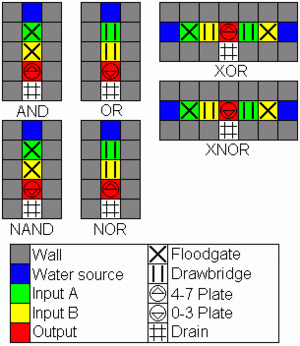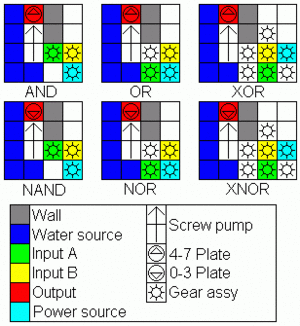- v50 information can now be added to pages in the main namespace. v0.47 information can still be found in the DF2014 namespace. See here for more details on the new versioning policy.
- Use this page to report any issues related to the migration.
40d:Fluid logic
Fluid logic is a form of computing which uses a fluid (generally water) controlled by various means, to trigger pressure plates and hopefully accomplish some desirable result.
Infinite Flow Gates
These logic gates are relatively simple and cheap to make, but require an infinite amount of water and infinite drainage to operate. Credit goes to numerous forum members for refining these designs.
Mechanical-Fluid Gates
The water sources in these diagrams are located 1 z-level below the pumps and gear assemblies.
These gate designs have the advantage of destroying no water and requiring no drainage off the map, making them suitable for maps where infinite water and/or drainage may be a problem. The only fluid lost will be to evaporation. However, there are a number of disadvantages. They require significantly more materials and time to make, they require power, and a flood could have disasterous consequences, as it would cover all the plates at once.
CMOS Transmission Gate and Inverter Logic
Perhaps the closest to utilizing water as a stand-in for electricity, transmission gate logic can be accomplished by simply having an infinite water source in place of all +Vs, and infinite drainage for all grounds. Simple floodgates behave as standard transmission gates, while bridges are inverted gates. However, unlike the other forms of fluid logic, but like a real world electrical circuit, a dedicated inverter is required, which must be hooked up to +V and ground.


